18.24 Past Paper Practise
Question 1:
The table below refers to four of the five taxonomic Kingdoms.
| Kingdom: | Features: | Examples: |
| Fungi | ||
| Protoctista | ||
| Plantae | ||
| Animalia |
(a) Select features from the following list and write them in the appropriate features box on the table. Some
features may be used more than once, or may not be relevant. You should write three features in each box.
has eukaryotic cells
has prokaryotic cells
has cellulosic cell walls
has chitinous cell walls
autotrophic
heterotrophic
consists of hyphae
often unicellular or groups of similar cells
always multicellular
have nervous coordination [4]
(b) Select organisms from the following list and complete the table by placing them in the appropriate examples
box. Give two examples in each box.
Green algae
Penicillium
Ferns
Mushrooms
Bacteria
Amoeba
Malarial parasite
Dicotyledons
Mucor
Frog
Moss
Viruses
Tape worm
Spider [4]
| Kingdom | Features | Examples |
| Fungi | eukaryotic heterotrophic consists of hyphae chitinous cell walls ; | mushrooms Penicillium Mucor ; |
| Protoctista | eukaryotic heterotrophic (some) autotrophic (some) unicellular or groups of similar cells ; | Amoeba green algae malarial parasite ; |
| Plantae | eukaryotic autotrophic multicellular cellulosic cell walls ; | moss ferns dicotyledons ; |
| Animalia | eukaryotic heterotrophic multicellular have nervous coordination ; | tape worm spider frog ; |
(a) 1 mark per box with three correct features and no incorrect features. 4
(b) 1 mark per box with two correct examples and no incorrect example. 4
Question 2:
The drawings illustrate the structure of six insects.
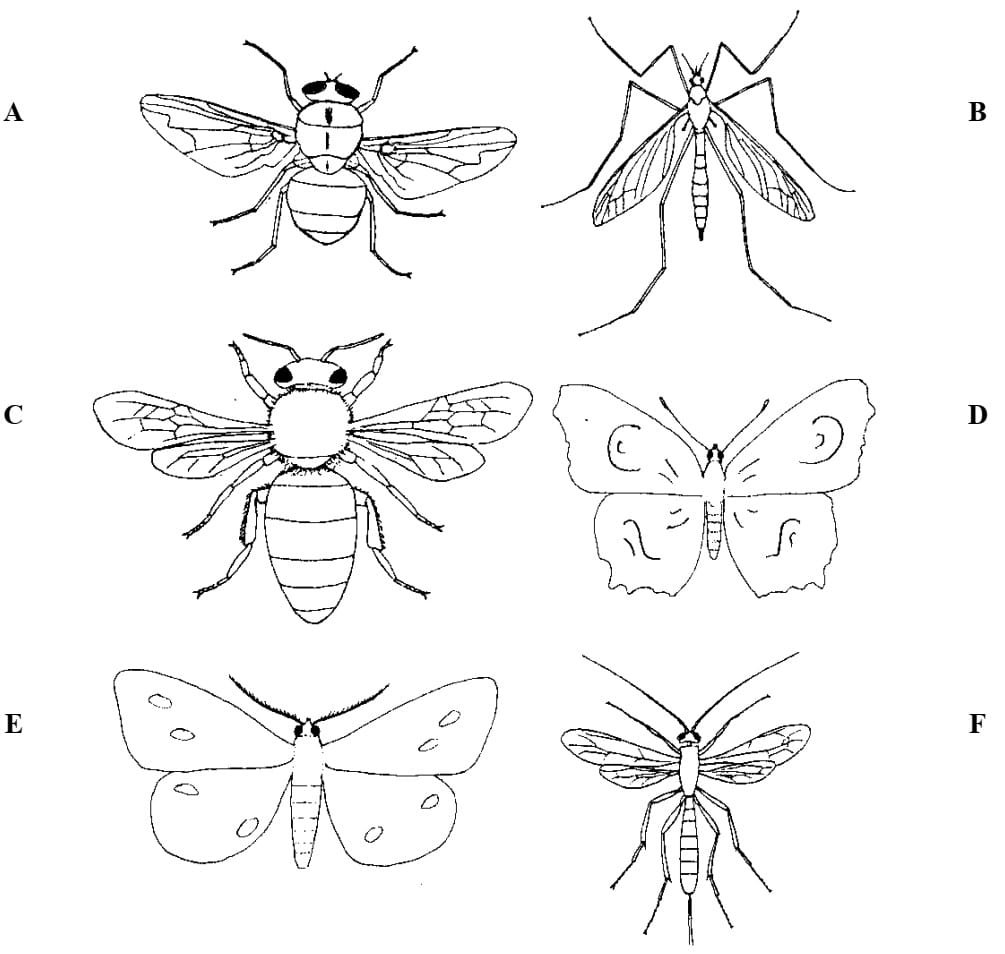
Make a simple dichotomous key which could be used to identify the six insects. Use only the following features in your key:
number of abdominal segments, wing number, wing size and shape, body shape, antennae, leg length.
It may not be necessary to use all these features in your key.
There are numerous ways of doing the key. The following is an example only.
- insect has 1 pair of wings go to 3
- insect has 2 pairs of wings go to 5
- abdomen has 4 segments Species A
- abdomen has 7 segments Species B
- antennae clubbed Species D
- antennae not clubbed go to 7
- wings small in area relative to body go to 9
- wings much larger than body Species E
- abdomen/body is thin Species F
- abdomen/body is thick Species C
Use of a truly dichotomous key; 1
1 mark per species correctly separated;;;;;; 6
Question 3:
Leaves consist of a leaf base which joins the stem near an axillary bud, a petiole and a leaf blade or lamina.
Leaves may be simple or compound, when they are divided into leaflets.
Devise a dichotomous key which would distinguish the following leaves. Only use features that are visible in the
drawings in your key.
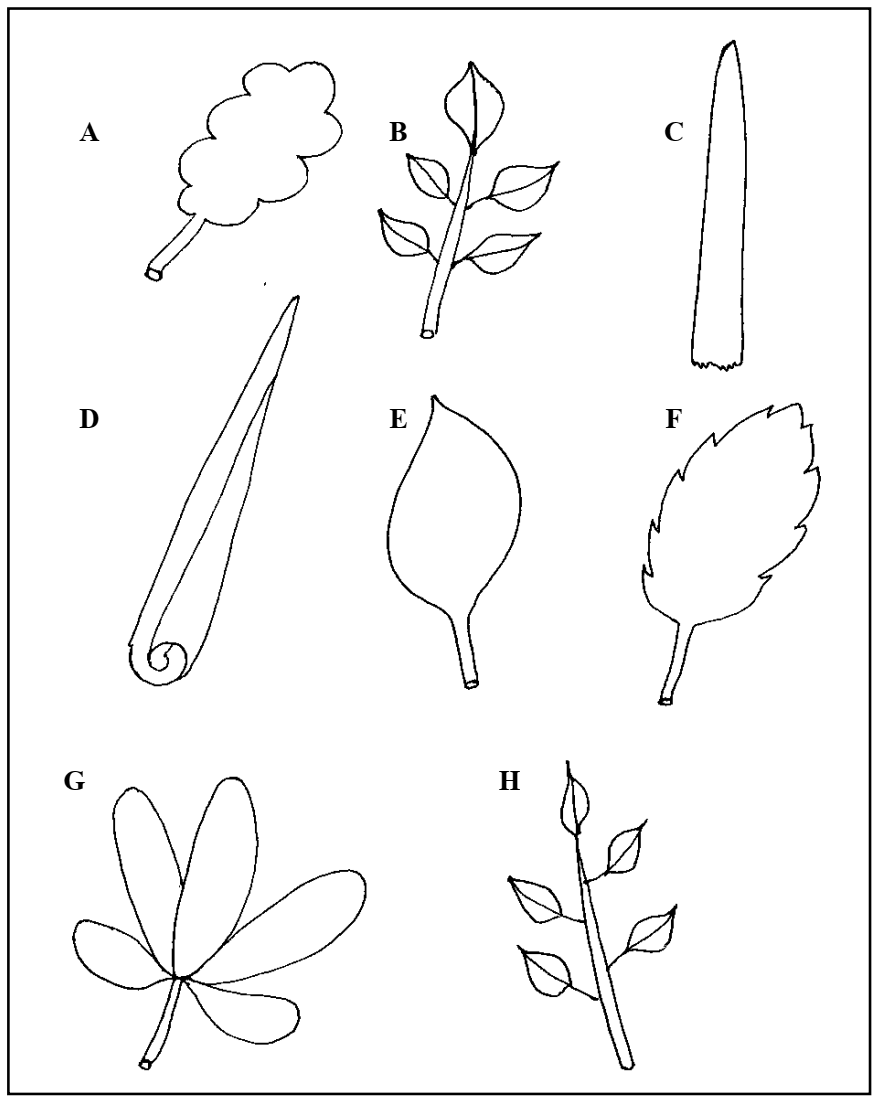
- leaves simple/not divided go to 3
- leaves compound/divided into leaflets go to 11
- leaves spear/lance shaped/isobilateral. go to 5
- leaves with broad lamina/dorsi-ventral go to 7
- leaf rolled/curled leaf D
- leaf flat leaf C
- leaf with smooth margin leaf E
- leaf with shaped margin go to 9
- margin lobed leaf A
- margin serrated leaf F
- leaflets all arise from tip of petiole leaf G
- leaflets arise along side of petiole go to 13
- leaflets arise opposite to each other. leaf B
- leaflets arise alternately/not opposite leaf H
Allow one mark for each leaf correctly separated;;;;;;;; 8
Allow one mark for a correct dichotomous key; 1
Accept alternative keys if correct and alternative wordings if clear
Question 4:
The diagrams below are of seven different Arthropods.
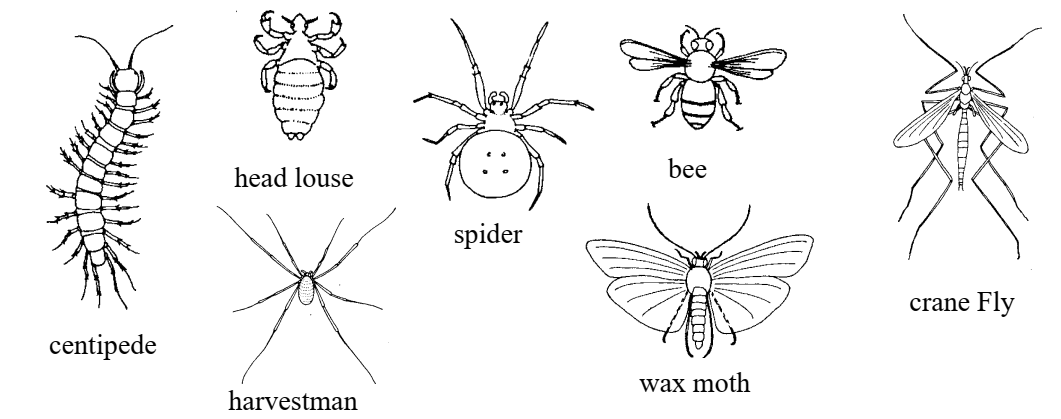
(a) (i) State a typical feature of Arthropods which is visible in all the organisms above. [1]
all possess jointed legs;
(ii) The phylum Arthropoda contains several classes, four of which are shown in the table below. Complete the table by naming the organisms above in the correct columns. [3]
| Insecta | Crustacea | Arachnida | Chilopoda (Myriapoda) |
| Insecta | Crustacea | Arachnida | Chilopoda (Myriapoda) |
| head louse bee wax moth crane fly ; | harvestman spider ; | centipede ; |
(b) Devise a simple dichotomous key which would distinguish between the seven organisms. Only use features that are visible in the drawings. [8]
1. organism has wings go to 3
2. organism wingless go to 7
3. organism with one pair of wings crane fly
4. organism with two pairs of wings go to 5
5. wings smaller than body/short antennae bee
6. wings larger than body/long antennae wax moth
7. has three pairs of legs head louse
8. has more than three pairs of legs go to 9
9. has many legs centipede
10. has four pairs of legs go to 11
11. body in one part harvestman
12. body in two parts spider
1 mark per organism correctly identified;;;;;;; 7
1 mark for correct dichotomy; 1
Question 5:
(a) (i) The following taxons are commonly used in the classification of organisms:
Species, Class, Order, Kingdom, Genus, Phylum and Family. Place the taxons into a correct sequence. [1]
Kingdom – Phylum – Class – Order – Family – Genus – Species;
(ii) State two differences between the Kingdom Fungi and the Kingdom Plantae. [2]
fungi are saprophytic/non-photosynthetic, plantae are photosynthetic;
fungal cell/hyphae walls do not contain cellulose, plant cell walls do;
fungi do not contain chlorophylls, plant cells do;
fungi have multinucleate hyphae, plants have cells with single nuclei;
(iii) State two differences between the Kingdom Protoctista and the Kingdom Prokaryotae. [2]
protoctista have nuclear membranes, prokaryotae do not;
protoctista have chromosomes, prokaryotae have a single chromosome/ nuclear mass;
protoctista have membrane bound organelles/mitochondria or other example, prokaryotae do not;
(b)The following organisms all belong to the Class Insecta but belong to different Orders of that group.

(i) Suggest three features shown by insects A, B and C that are characteristic of the Class Insecta. [3]
body in three parts/head + thorax + abdomen;
three pairs of legs;
compound eyes;
one pair of antennae;
thorax has three segments;
any other valid feature;
(ii) Suggest two features, which differ in each insect, which could be characteristic of different Orders. [2]
A has two pairs of wings, C has one pair and B is wingless;
A has a very narrow ‘waist’, C has a thicker ‘waist’ and B has no ‘waist’;
A has a long sting/ovipositor, C has a short sting/ovipositor and B does not have one;
(c) Organism B is a common ectoparasite of humans and other mammals, and can act as a disease vector.
(i) What is insect B? [1]
a flea;
(ii) Suggest an adaptation that it possesses which enables it to transfer easily from host to host. [1]
elongated/powerful back legs for jumping;
(iii) Name a disease which it transfers to humans. [1]
plague/bubonic plague;
Question 6:
The kingdom Prokaryotae contains single celled organisms like non-photosynthetic bacteria, for example, Escherichia coli, and photosynthetic blue green bacteria, for example, Nostoc. The drawing below shows the ultrastructure of E. coli.
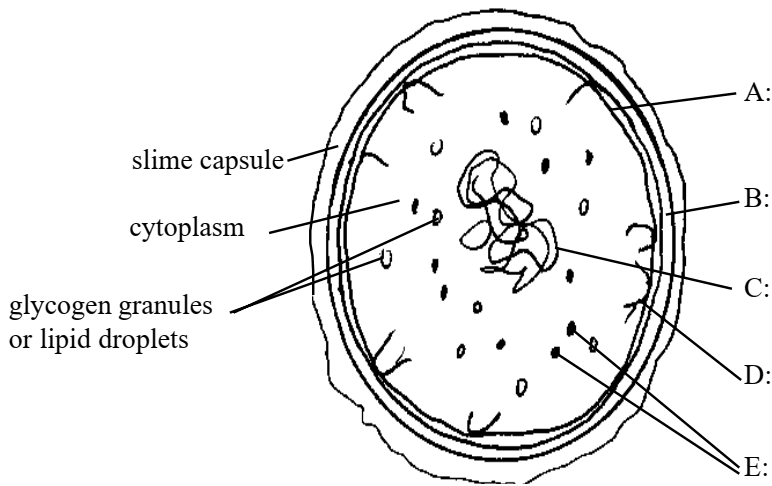
(a) (i) Label structures A to E on the drawing. [5]
A = plasma membrane; B = cell wall; C = nuclear mass; D = mesosome; E = ribosomes;
(ii) State a function of part D. [1]
contain the enzymes for respiration/cell wall synthesis;
(iii) What term is given to this bacterial shape? [1]
coccus;
(b)(i) List three ways in which prokaryotic cells differ from eukaryotic cells. [3]
prokaryotic cells contain no membrane-bound organelles, eukaryotes do;
prokaryote cells have no nuclear membrane, eukaryotes do/prokaryotes have a nuclear mass, eukaryotes have
a nucleus/prokaryotes have one long chromosome, eukaryotes have many chromosomes;
prokaryotes have no nucleoli, eukaryotes do;
prokaryotic cell walls contain murein, eukaryotic cell walls (if present) contain cellulose;
(ii) Nostoc used to be classed as a blue green alga. Why was this illogical? [1]
Nostoc is prokaryotic but algae are eukaryotic;
(iii) Suggest where the photosynthetic pigments are found in a blue green alga such as Nostoc. [1]
in the cytoplasm/in vesicles/in chromatophores;
Question 7:
The table below refers to viruses, bacteria, algae and protozoa. If the statement is correct for the organism place
a tick (3) in the appropriate box and if a statement is incorrect, place a cross (7) in the appropriate box.
| Feature | Viruses | Bacteria | Algae | Protozoa |
| Cannot reproduce independently | ||||
| Are heterotrophic | ||||
| Can cause diseases | ||||
| Contain DNA or RNA but not both | ||||
| Can photosynthesise |
| Feature | Viruses | Bacteria | Algae | Protozoa |
| Cannot reproduce independently | ✓ | ✗ | ✗ | ✗ |
| Are heterotrophic | ✗ | ✓ | ✗ | ✓ |
| Can cause diseases | ✓ | ✓ | ✗ | ✓ |
| Contain DNA or RNA but not both | ✓ | ✗ | ✗ | ✗ |
| Can photosynthesise | ✗ | ✓ (some species can) | ✓ | ✗ |
Question 8:
Organisms and biological structures may be radially or bilaterally symmetrical. In radial symmetry an organism can be cut in any vertical plane to give two halves which are mirror images of each other. In bilateral symmetry there is only one vertical plane through which the organism could be cut to obtain two mirror image halves. The diagrams below show various organisms or organs which have different symmetries.
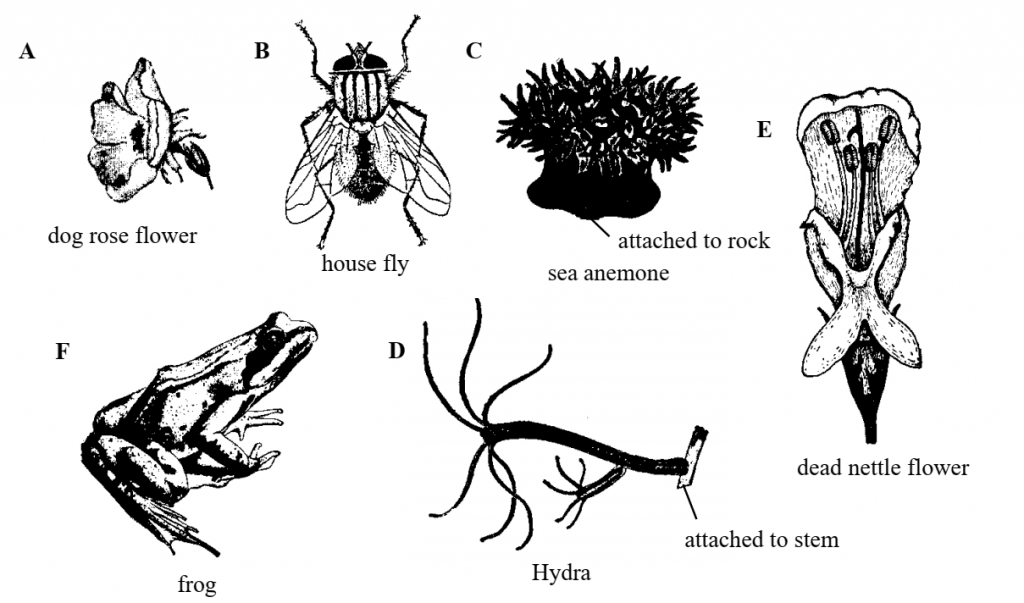
(a) (i) For each of the organisms or organs above state whether it is radially or bilaterally symmetrical. [6]
A = radial; B = bilateral; C = radial; D = radial; E = bilateral; F = bilateral;
(ii) Suggest two advantages that their symmetry gives to animals C and D. [2]
can receive/obtain food (with equal ease) from any direction;
can receive sperm/gametes (with equal ease) from any direction;
can receive stimuli from all directions/has ‘all round’ awareness;
(iii) What advantage does the symmetry of the dog rose flower give to it? [1]
has an equal chance of receiving/attracting an insect from any direction;
can shed seeds/fruits equally well in all directions;
(b)(i) State one feature shown by the housefly that is common to arthropods. [1]
has jointed legs;
(ii) State two features shown by the house fly that are common to insects. [2]
body in three parts/head, thorax, abdomen;
has compound eyes;
has 1 pair of antennae;
has three pairs of legs; (reject wings, some insects are wingless)
(c) (i) Though the frog, as an Amphibian, lives primarily on land, it still shows several aquatic features. Suggest
two such features. [2]
webbed (hind) feet;
moist skin/skin used as respiratory surface;
must return to water to breed;
has an aquatic tadpole larva;
(ii) The dead nettle flower is insect pollinated. Suggest two features it could possess to aid insect pollination. [2]
nectar (to attract insects);
coloured/red/white (to attract insects);
petals/corolla provides a landing stage (for insects);
Question 9:
Biologists have traditionally recognised three different subspecies of chimpanzee based on physical characteristics,
genetics and geography. Pan troglodytes troglodytes lives in Central Africa, Pan troglodytes schweinfurthei
lives in East Africa and Pan troglodytes verus lives in West Africa.
Recently, a small new population of chimpanzees living in southeastern Nigeria has come to the attention of
biologists. It is suspected that this small population make up a new subspecies. Genetic analysis of animals for
taxonomic purposes is usually carried out on mitochondrial DNA, using genetic fingerprinting and DNA
hybridisation studies.
In DNA hybridisation, purified DNA from two subspecies are heated to separate the strands, these are mixed
together and allowed to cool. As they cool the strands rejoin to form double helices, however, some helices will
be hybrid, consisting of a strand from each subspecies.
The strands in hybrid DNA separate at a lower temperature than those in single subspecies DNA. The more
divergent the two subspecies the greater the difference between the separation temperatures of the hybrid and
single species DNA.
The table below shows the difference between the separation temperatures of hybrid DNA and single subspecies
DNA for the various groups of chimpanzees.
| Sources of hybrid DNA | Difference in separation temperature/oC |
| Pan troglodytes troglodytes/Nigerian group | 1.0 |
| Pan troglodytes schweinfurthei/Nigerian group | 1.1 |
| Pan troglodytes verus/Nigerian group | 0.85 |
| Pan troglodytes troglodytes/Pan troglodytes schweinfurthei | 0.6 |
| Pan troglodytes troglodytes/Pan troglodytes verus | 0.7 |
| Pan troglodytes schweinfurthei/Pan troglodytes verus | 0.85 |
(a) (i) Suggest why strands in hybrid DNA separate at lower temperatures than single subspecies DNA. [2]
some lengths of DNA strands will not have complementary bases;
thus will not be joined by hydrogen bonds/double helix held together by fewer hydrogen bonds;
thus less energy required to split strands apart;
(ii) Suggest why separation temperatures show greater differences between less closely related subspecies. [2]
the further subspecies diverge the more discepancies occur between complementary bases;
thus fewer hydrogen bonds anchor the DNA strands in hybrid DNA of distant subspecies;
(iii) Comment on the possible significance of the differences shown in separation temperatures shown in the table. [3]
greatest differences in separation temperatures of Nigerian group and other three subspecies;
suggesting that they are fairly divergent groups/Nigerian group may be a separate subspecies;
Nigerian group is probably genetically closest to Pan troglodytes verus;
Pan troglodytes troglodytes is probably closest to Pan troglodytes schweinfurthei;
(accept any other reasonable comments)
(b)(i) What features of genetic fingerprints are used in assessing affinities between organisms? [2]
whether DNA fingerprints of different organisms show corresponding dark bands;
these indicate matching/corresponding base/nucleotide sequences;
ref to visualisation by radioactive gene probes, labelled sequences show up as dark bands on film;
(ii) Using information from the temperature separation data above, suggest a pair of subspecies or possible
subspecies which would probably:
1. show the greatest similarity in their DNA fingerprints. [1]
2. show the greatest diversity in their DNA fingerprints. [1]
1.Pan troglodytes troglodytes and Pan troglodytes schweinfurthei;
2. Pan troglodytes schweinfurthei and the Nigerian group;
Question 10:
The full classification of the tiger is as follows:
Kingdom: Animalia
| Phylum: | Chordata |
| Class: | Mammalia |
| Order: | Carnivora |
| Family: | Felidae |
| Genus: Species: | Panthera P. tigris |
(a) (i) Suggest two features of tigers that place them into the animal kingdom. [2]
has nervous coordination;
is non-photosynthetic/heterotrophic;
(ii) Suggest two features of tigers that place them into the phylum Chordata. [2]
has a notochord;
has a dorsal hollow nerve cord;
has visceral clefts;
has a post-anal tail;
(iii) Suggest two features of tigers that place them in the class Mammalia. [2]
has skin with hair in follicles;
viviparous/has gestation periods/young born from uterus;
has mammary glands/young fed on milk;
(iv) Suggest one feature of a tiger that places it in the order Carnivora. [1]
only eats meat/ref to dentition;
(b)(i) The family Felidae is the cat family. Suggest another family of animals which is classified in the Carnivora. [1]
dog family/Canidae/bear family/Ursidae/any other correct example;
(ii) The genus Panthera includes the tigers and panthers. Name another genus of the family Felidae. [1]
Leo/lion genus/Felis/domestic cat genus/any other correct example;
(c) The classification of a group of organisms is supposed to represent their phylogeny. What does this mean? [2]
the classification represents the evolutionary history/evolutionary affinities of organisms;
the closer two types of organisms are in the classification the closer their evolutionary relationship;
Question 11:
The drawings below illustrate the heads (scolices) of six tapeworms which show differing arrangements of hooks and suckers.

(a) What are the functions of the suckers and hooks? [2]
tapeworms are parasites inside gut/other organs/endoparasites;
hooks and suckers enable their heads to attach (strongly) to host organs;
(b) Devise a dichotomous key which would distinguish the six species of tapeworms shown above. Only use
features which you can see in the drawings. [7]
1. head with no hooks/suckers only go to 3
2. head with hooks and suckers go to 5
3. head with two simple suckers species A
4. head with four leaf like suckers (and four simple suckers) species D
5. head with one row of hooks go to 7
6. head with more than one row of hooks go to 9
7. hooks small, three large suckers visible/four large suckers species E
8. hooks large, two small suckers and two large suckers visible species C
9. two rows of small hooks, three large suckers visible/four large suckers species B
10. two groups of hooks on head, many hooks on ‘neck’, two large suckers species F
1 mark for each correct identification = 6 marks;;;;;;
1 mark for a correct dichotomous key;
Question 12:
(a) List two features shown by a bacterium such as Escherischia coli and a cyanobacterium, such as Nostoc, which place them both in the kingdom Prokaryotae. [2]
lack nuclear membranes/organised nuclei;
lack membrane bound organelles;
lack 9 + 2 microtubule organelles;
(b)List two features shown by Mucor (pin mould) and a mushroom which place them both in the kingdom Fungi. [2]
have multinucleate hyphae;
no cellulose in walls/have chitin rather than cellulose;
heterotrophic nutrition by direct absorption/extracellular digestion;
have spores without flagella;
(c) List two features shown by a moss and a pine tree which place them both in the kingdom Plantae. [2]
cell walls contain cellulose;
multicellular photosynthetic eukaryotes;
(d) Suggest two features which distinguish monocotyledonous plants from dicotyledonous plants. [2]
monocotyledons have only one seed leaf, dicotyledons have two;
monocotyledons have leaves with parallel veins, dicotyledons have leaves which are net-veined;
monocotyledons have floral parts in threes, dicotyledons have floral parts in fives (usually)
(e) Why are fishes, frogs and elephants classed together in the phylum Chordata? [2]
all contain a notochord (at some stage);
all have a dorsal, hollow nerve cord;
all have visceral clefts;
all have a post-anal tail;
(f) Why are dolphins, bats, weasels, seals and humans placed together in the class Mammalia? [2]
all have skin with hair follicles;
all are viviparous/young born from uterus/have pregnancies;
young are fed on milk/have mammary glands/suckle young;